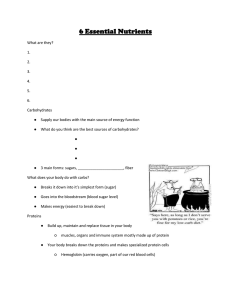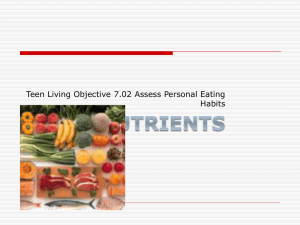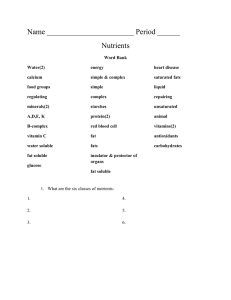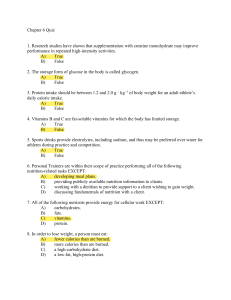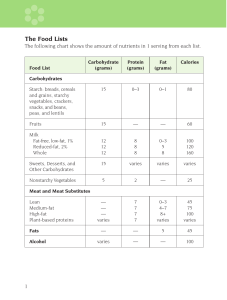Nutrition
advertisement
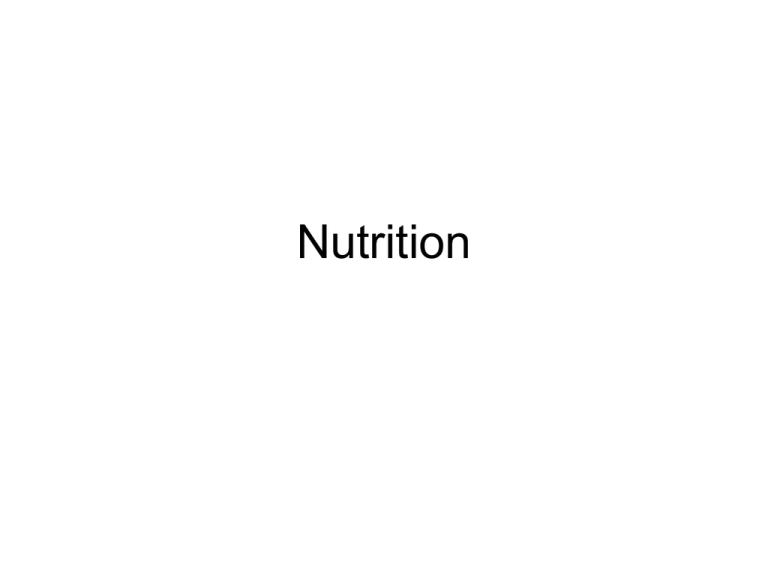
Nutrition Nutrition is used to restore, repair or regenerate the body • repairs damaged tissue • recuperate fatigued muscles • regenerate lost energy • keeps body functions intact Many people (elite athletes) don’t follow good nutritional guidelines or it takes them a long time to figure it out How do we get good nutrition? What guidelines can we follow? Should have: 55%-60% Carbohydrates 30% or less Fat 10%-15% Protein If you are exercising very hard more than one time per day, then follow higher % for protein. Four food groups Old Method 1) milk & dairy 2-3 serving (1/2 cup) 2) meat, poultry & fish 2 serving (2-3oz) alt with nuts (1/2 cup) 3) bread & cereals 3-4 servings (slices, 3/4 cup) 4) fruit & veg 4-5 servings (1/2 cup, medium fruit) Food Pyramid Old Method My Pyramid Old pyramid http://www.mypyramid.gov Carbohydrates 4 calories/gram made from starches & sugars found in bread, pastries, vegetables and fruits converted into an energy source called glycogen, excess is stored as fat can be stored in liver and muscle cells first energy to be called on Protein 4calories/gram composed of amino acids excess can also be stored as fat takes a lot of water to digest = more weight eating extra protein will not increase your muscle mass Fat 9 calories/gram very good energy source hard to get to the system to burn it, slower to digest used mostly when carbohydrates are gone may cause gastric distress Vitamins Two types: 1) Fat soluble Examples A, D, E, K -toxic if large quantities are stored in the body -Usually not destroyed by cooking -get them by eating butter, liver and animal products 2) Water Soluble Examples B’s, C -usually lost through cooking and boiling -not toxic because they pass through the system with water Vitamins (con’t) The body doesn’t/can’t manufacture vitamins except vitamin D (with the help of sunlight) We need supplements or a balanced diet to get them Vegetarians have a hard time getting enough fat soluble vitamins Minerals Important for the formation of tissue (bone & teeth) Aid in Metabolism Usually meet requirements by eating fruits and vegetables Iron is usually the hardest for women to get and keep Water forms 75% of all living things accounts for 60% of body mass male = 60% female = 50% muscular = 70% obese = 40% newborns = 80% functions of water *part of every body fluid *act as carriers for substances *assists with temperature regulation *necessary for chemical regulation *lubricates joints *keeps alveoli of lungs moist Water (con’t) thirst is not an adequate indicator of hydration. by the time you feel thirsty you are already beginning to dehydrate daily intake should be as follows: ~ 64 oz per day a 2% water weight loss during exercise can cause fatigue, loss of concentration, increase in heart rate a 5% water weight loss during exercise can lead to serious heat injury


